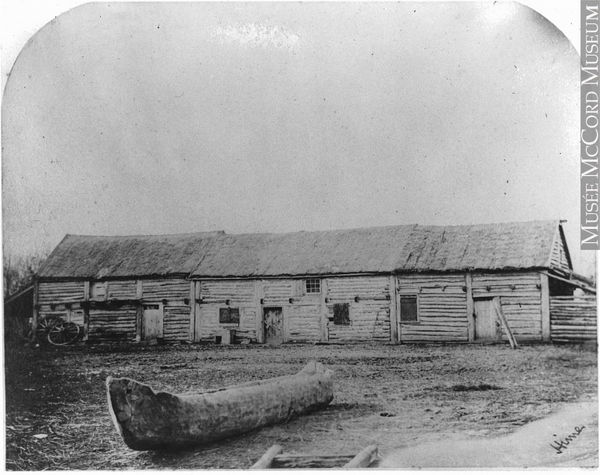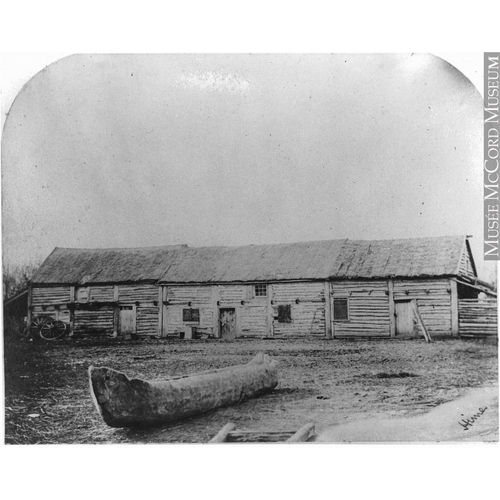
Source: Link
McDERMOT, ANDREW, HBC employee, merchant, and office-holder; b. in 1790 at Belanagare, County Roscommon (Republic of Ireland), the eldest son of Miles MacDermot and Catherine (Kitty) O’Connor; m. c. 1814 Sarah McNab (d. 1875), and they had 17 children; d. 12 Oct. 1881 at Winnipeg, Man.
Andrew McDermot was educated at home by the “hedge-schoolmasters” who taught Roman Catholic children in secret during the penal times in Ireland. As there were few opportunities for advancement in Ireland, McDermot joined the Hudson’s Bay Company and sailed from Sligo on 24 June 1812, arriving at York Factory (Man.) 26 August on the Robert Taylor. A mutiny broke out when the steerage passengers protested about insufficient provisions, and McDermot signed their manifesto. There were further problems when discontent developed between Irish passengers and a party of settlers sent out by Lord Selkirk [Douglas*]. McDermot learned to speak Gaelic from Scottish Highlanders during the two-month voyage.
Engaged by the HBC as a writer for three years at £30 per annum, McDermot spent the first two seasons in the East Winnipeg District. For the 1814–15 trading season, he was promoted to assistant writer and trader and placed in charge of the small HBC post on the Berens River, where he remained until 1816. He was described as “Sober. Honest. Ready and willing in the discharge of his duty. Obedient & respectful of his superiors. . . . He has a tolerably good knowledge of the Indian language.”
In 1816 he was promoted to clerk and transferred to Big Point House, approximately nine miles south of Lake Dauphin, to oppose the North West Company in the Lake Manitoba area. Two years later he was made a trader with a salary of £40 per annum, and following the union of the HBC and the NWC in 1821, McDermot was moved to the Lower Red River District with a salary of £45 per annum. At the expiry of his contract in 1824, he was permitted to retire.
McDermot disliked the slow advancement offered by the fur trade and, wanting to be his own master, opened a store just north of the HBC reserve at Fort Garry. The company considered it desirable to have stores run by private individuals to supply the settlers’ demands for articles it did not provide, and McDermot was also allowed to import goods in the company’s ships via York Factory. He prospered and soon acquired his own brigade of York boats to carry goods between York Factory and the Red River Settlement. In an attempt to keep furs from going to the rival American post at Pembina (N. Dak.), the HBC gave McDermot a special licence to engage in the fur trade, and he resold his furs to the company at a profit. His friendship with Governor George Simpson* secured him contracts with the HBC for freighting goods, exporting tallow to England on company ships, importing rum, supplying Upper and Lower Fort Garry with firewood and provisions for horses, and importing cattle from the United States. His business increased with the arrival of the 6th Regiment of Foot in 1846 under the command of John ffolliott Crofton, and that year he sent Simpson £2,000 sterling to invest for him. Simpson continued to manage McDermot’s investments in subsequent years.
McDermot also speculated profitably in land. The executors of the Selkirk estate granted him a lot in the parish of St John’s in 1824 and he acquired additional lots in the parishes of St James, St Charles, and St Boniface. He constructed water-mills at his home, Emerald Lodge, and at Sturgeon Creek and Rowlings Creek, and a steam-mill at Portage la Prairie. Emerald Lodge, often referred to as McDermotown, became the nucleus of Winnipeg, and the McDermot Avenue of today marks the northern boundary of this property.
In anticipation of the passing of the ownership of the District of Assiniboia from the Selkirk estate to the HBC in 1836, the membership of the Council of Assiniboia was increased from 5 to 15 to make it more representative. McDermot, as an important member of the community, was invited to attend the first meeting of the reorganized council on 12 Feb. 1835. He was appointed to the public works committee which was responsible for the construction of roads and bridges, surveying, the operation of ferries, and public improvements. He became a councillor of Assiniboia in 1839.
McDermot and James Sinclair* were the moving force behind the free trade movement that culminated with the trial of Pierre-Guillaume Sayer* in 1849. In an effort to curb the activities of the two leaders, Chief Factor Duncan Finlayson* had refused to renew their freighting contract with the HBC in 1843, and the following year Chief Factor Alexander Christie*, governor of Assiniboia, issued a proclamation against the illegal traffic in furs and stated that all mail would be censored. In 1845 goods ordered from the United Kingdom by McDermot and Sinclair were refused space in company ships. Christie, supported by Adam Thom, continued to tighten his restrictions, but by the end of the year acknowledged that the private trade could no longer be checked by such measures. In April 1846 Christie wrote to Simpson that the dispute would be a real test of the company’s power and determine whether it or a confederacy of smugglers would be paramount. The influenza epidemic of 1846, together with the arrival of the 6th Regiment, eased the threat of rebellion. An understanding was reached whereby McDermot received a partial payment for his losses and was allowed to sell his furs and to use the company’s ships again for export and import through York Factory.
McDermot had resigned from the Council of Assiniboia over his dispute with Governor Christie. Persuaded to return, he took the oath of office on 15 Jan. 1847. He was appointed ex officio president of the General Quarterly Court of Assiniboia in August 1849. In May 1851 he resigned from both offices, stating that he had more than he could manage with his own private affairs, but the real reason was his lack of confidence in Major William Bletterman Caldwell, the new governor of Assiniboia, whom he claimed was unacquainted with both business and the art of government. McDermot refused further offers of public office but was persuaded to become a justice of the peace for Manitoba in 1871.
When the disturbances of 1869–70 came to upset the settlement, McDermot was an old man, retired from business since 1866. His sons-in-law, Andrew Graham Ballenden Bannatyne and Thomas Bird, and his son Henry McDermot managed his business interests. Though McDermot did not approve of Louis Riel’s actions, he took no active part in events.
As a senior resident of the province, McDermot was given the honour of heading the deputation and addressing congratulations to Lieutenant Governor Adams George Archibald* upon his departure from Manitoba in 1872. The recommendation by Donald Alexander Smith* in 1872 which led to McDermot’s appointment as Manitoba’s representative among the provisional directors of the Canadian Pacific Railway was yet another tribute. McDermot was regarded as a remarkable man. He was reputed at his death on 12 Oct. 1881 to have been the wealthiest man in Manitoba and one of the most generous. He donated the land for Winnipeg’s first post office, and, with Bannatyne, the land for the Winnipeg General Hospital. He was sociable and always kept an open house, and his personal charm as well as a somewhat erratic and roguish temperament, seemed to draw all and sundry to him.
Born a Roman Catholic, McDermot had left that Church in 1866, and even Archbishop Alexandre-Antonin Taché*’s efforts could not win him back. He was buried in the Church of England cemetery of St John’s Cathedral.
PAM, MG 2, A6; C8; C14: nos.100, 287, 513; HBCA, D.5. HBRS, XIX (Rich and A. M. Johnson). A. Ross, Red River Settlement. W. J. Healy, Women of Red River: being a book written from the recollections of women surviving from the Red River era (Winnipeg, 1923). D. G. Lent, West of the mountains: James Sinclair of the Hudson’s Bay Company (Seattle, Wash., 1963).
Cite This Article
Barry E. Hyman, “McDERMOT, ANDREW,” in Dictionary of Canadian Biography, vol. 11, University of Toronto/Université Laval, 2003–, accessed November 20, 2024, https://www.biographi.ca/en/bio/mcdermot_andrew_11E.html.
The citation above shows the format for footnotes and endnotes according to the Chicago manual of style (16th edition). Information to be used in other citation formats:
| Permalink: | https://www.biographi.ca/en/bio/mcdermot_andrew_11E.html |
| Author of Article: | Barry E. Hyman |
| Title of Article: | McDERMOT, ANDREW |
| Publication Name: | Dictionary of Canadian Biography, vol. 11 |
| Publisher: | University of Toronto/Université Laval |
| Year of publication: | 1982 |
| Year of revision: | 1982 |
| Access Date: | November 20, 2024 |



